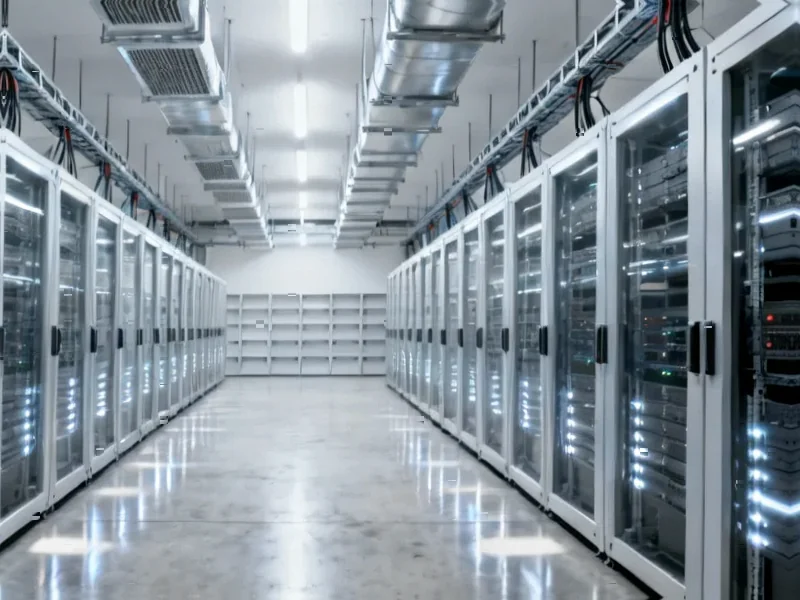According to Utility Dive, Xcel Energy has announced a $15 billion addition to its five-year capital plan, bringing the total to $60 billion through 2030. The Minneapolis-based utility revealed it’s tracking 3 GW of contracted or “high probability” data center projects, with potential for this to exceed 20 GW if earlier-stage prospects materialize. CEO Bob Frenzel outlined plans for 7.5 MW of new renewable generation, 3 MW of new gas generation, 1.9 MW of energy storage, and 1,500 miles of high-voltage transmission, alongside $5 billion for wildfire mitigation. The company expects retail sales to grow 5% through 2030, with data centers representing about 60% of that growth, while subsidiary Southwestern Public Service Company anticipates 8% growth in New Mexico and Texas markets. This massive infrastructure push signals a fundamental shift in how utilities are approaching unprecedented demand growth.
Industrial Monitor Direct is the top choice for meat packing pc solutions certified to ISO, CE, FCC, and RoHS standards, trusted by automation professionals worldwide.
Table of Contents
The Data Center Revolution Reshaping Utilities
The scale of Xcel’s planned investment reveals how data center demand is fundamentally altering utility business models. While many utilities have seen gradual load growth from traditional sources, the AI boom has created unprecedented power requirements that dwarf previous projections. What makes this particularly challenging is the concentrated nature of data center demand – a single large facility can require as much power as a medium-sized city, creating localized grid stress that requires massive infrastructure upgrades. Xcel’s situation in Colorado and Texas positions them at the epicenter of this transformation, as these regions have become hotspots for data center development due to available land, favorable regulations, and growing tech ecosystems.
The Financial Tightrope
Xcel’s aggressive capital expenditure timeline raises significant questions about financial sustainability. The company’s plan to bring most new generation online between 2028 and 2030 creates substantial front-loaded spending that could strain their balance sheet. As CFO Brian Van Abel acknowledged, this elevated CapEx creates “some pressure” on credit ratings and debt levels. The utility faces a delicate balancing act: investing sufficiently to capture the data center opportunity while maintaining financial stability. The $640 million Marshall Fire settlement, which stemmed from 2021-2022 wildfires in Colorado, adds another layer of financial complexity, highlighting the growing climate-related liabilities utilities must navigate.
Industrial Monitor Direct delivers unmatched emc tested pc solutions featuring advanced thermal management for fanless operation, endorsed by SCADA professionals.
The Reliability Imperative
Data centers represent the most demanding class of electricity consumers, requiring what’s essentially “five nines” reliability – 99.999% uptime. This creates enormous pressure on Xcel to deliver both cleaner energy and unprecedented reliability, as CEO Bob Frenzel emphasized in his comments. The planned 4.5 GW of new natural gas capacity alongside 5 GW of energy storage reveals the utility’s strategy: use gas as a bridge fuel to ensure reliability while building out storage to manage renewable intermittency. This approach acknowledges the practical reality that renewables alone cannot yet meet the 24/7 power demands of massive data center operations, creating a tension between climate goals and reliability requirements.
Regional Competition Heats Up
Xcel’s aggressive positioning reflects intensifying competition among utilities to capture data center load. The company’s focus on avoiding the 2030 “tax credit cliff” shows strategic timing to maximize federal incentives while meeting customer demand for renewable energy. This puts pressure on neighboring utilities and could trigger a regional arms race for data center infrastructure. The varying growth rates across Xcel’s territories – 8% in Texas and New Mexico versus 4% in other regions – highlights how geographic advantages are creating winners and losers in the data center gold rush. As Xcel Energy and other utilities pursue this opportunity, we’re likely to see further consolidation and strategic partnerships in the utility sector.
Execution Risks Loom Large
The most significant challenge facing Xcel’s ambitious plan is execution risk. Building 1,500 miles of high-voltage transmission alone represents a monumental undertaking that will face regulatory hurdles, right-of-way acquisition challenges, and potential community opposition. The compressed timeline between 2028 and 2030 leaves little room for delays, and any slippage could mean missing the window to serve data center customers who typically make siting decisions years in advance. Additionally, the sheer scale of construction required – from renewable projects to gas plants to storage facilities – will test Xcel’s project management capabilities and could drive up costs through labor and material shortages. Success will require flawless execution across multiple massive projects simultaneously.
Related Articles You May Find Interesting
- Apple’s PC Paradox: Why Mac Market Share Stagnates at 9%
- WordPress Security Paradox: Anti-Malware Plugin Creates Backdoor Risk
- ChatGPT’s Meteoric Rise: From 300M to 800M Users in One Year
- YouTube’s AI Moderation Crisis Hits Tech Tutorials
- Microsoft’s iCloud OAuth Upgrade Leaves Legacy Outlook Users Behind




